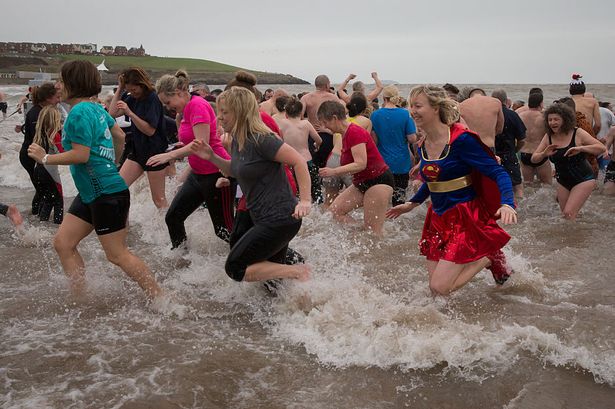The invigorating plunge into icy waters on New Year’s Day has become a beloved tradition for many, a symbolic cleansing of the past year and a bracing welcome to the new. Often undertaken for charitable causes, these events draw crowds of enthusiastic participants eager to test their mettle and contribute to a worthy cause. While the spirit of camaraderie and the virtuous intentions are undeniable, it’s crucial to acknowledge and prepare for the significant physiological challenges presented by cold water immersion. Failing to do so can transform an exhilarating experience into a dangerous one, potentially leading to serious health complications and even tragedy. Understanding the body’s response to cold shock, hypothermia, and other cold-water related risks is essential for anyone considering a New Year’s Day swim or any other cold-water immersion activity.
The initial plunge into frigid water triggers a cascade of physiological responses collectively known as cold shock. The sudden drop in temperature causes an immediate gasp reflex, which can lead to involuntary inhalation of water, a particularly dangerous situation for those already submerged. Simultaneously, the body experiences rapid vasoconstriction, the narrowing of blood vessels in the extremities to conserve core body heat. This mechanism, while protective in the short term, can lead to a dramatic increase in blood pressure and heart rate, placing significant strain on the cardiovascular system. Individuals with underlying heart conditions or other health vulnerabilities are particularly susceptible to these adverse effects. The sudden change in temperature can also trigger disorientation and panic, making it difficult to coordinate movements and increasing the risk of drowning, even in relatively shallow water. Understanding and anticipating these immediate responses is crucial for safely navigating the initial stages of cold water immersion.
Beyond the immediate shock, prolonged exposure to cold water leads to progressive heat loss and the onset of hypothermia. As core body temperature drops, physiological functions begin to deteriorate. Shivering, initially a defense mechanism to generate heat, becomes increasingly violent and eventually ineffective. Cognitive function declines, leading to confusion, disorientation, and impaired judgment. Motor skills also deteriorate, making it difficult to swim or even tread water. As hypothermia progresses, the body enters a state of metabolic shutdown, leading to unconsciousness and ultimately, if untreated, death. The rate at which hypothermia develops depends on various factors, including water temperature, body composition, and individual tolerance. However, even in relatively mild conditions, prolonged exposure can have serious consequences, underscoring the importance of limiting immersion time and having appropriate safety measures in place.
Preparing for a New Year’s Day swim or any cold water immersion requires careful planning and attention to several key factors. First and foremost, consult with a physician to assess your individual health risks and determine whether cold water immersion is safe for you. Individuals with pre-existing heart conditions, respiratory problems, or other health vulnerabilities should exercise extreme caution and may be advised to avoid cold water immersion altogether. Acclimatization is also crucial; gradually exposing the body to progressively colder water temperatures over time can help build tolerance and reduce the severity of the cold shock response. Never jump directly into icy water without prior acclimatization, especially if you are unaccustomed to cold water immersion. Choosing an appropriate location is equally important. Select a supervised area with readily available safety personnel and equipment. Avoid swimming alone and inform someone of your plans, including your intended entry and exit points and estimated time in the water.
Proper clothing and equipment can significantly enhance safety and comfort during cold water immersion. Wearing a wetsuit or drysuit provides insulation and helps retain body heat, significantly extending the time it takes for hypothermia to set in. A brightly colored swim cap increases visibility in the water, aiding rescuers in locating you in case of an emergency. Consider wearing neoprene gloves and boots to protect extremities from the cold and maintain dexterity. Having a thermal blanket or warm, dry clothes readily available immediately after exiting the water is crucial for preventing further heat loss and aiding recovery. Post-immersion, rewarming should be gradual and focused on restoring core body temperature. Avoid consuming alcohol as it can interfere with the body’s natural thermoregulation processes and exacerbate the risks of hypothermia. Instead, opt for warm, non-alcoholic beverages and high-energy foods to replenish lost calories.
Finally, it is crucial to emphasize that safety should always be the paramount concern when considering a New Year’s Day swim or any cold water immersion activity. While the tradition can be a fun and invigorating way to celebrate the new year and support charitable causes, the potential risks should never be underestimated. Thorough preparation, including medical consultation, acclimatization, appropriate clothing and equipment, and adherence to safety guidelines, is essential for minimizing these risks and ensuring a positive and safe experience. Understanding the physiological effects of cold water immersion and respecting the power of the elements are fundamental to enjoying this challenging yet rewarding activity responsibly. By prioritizing safety and taking appropriate precautions, participants can transform a potentially dangerous plunge into a truly memorable and enriching experience.














